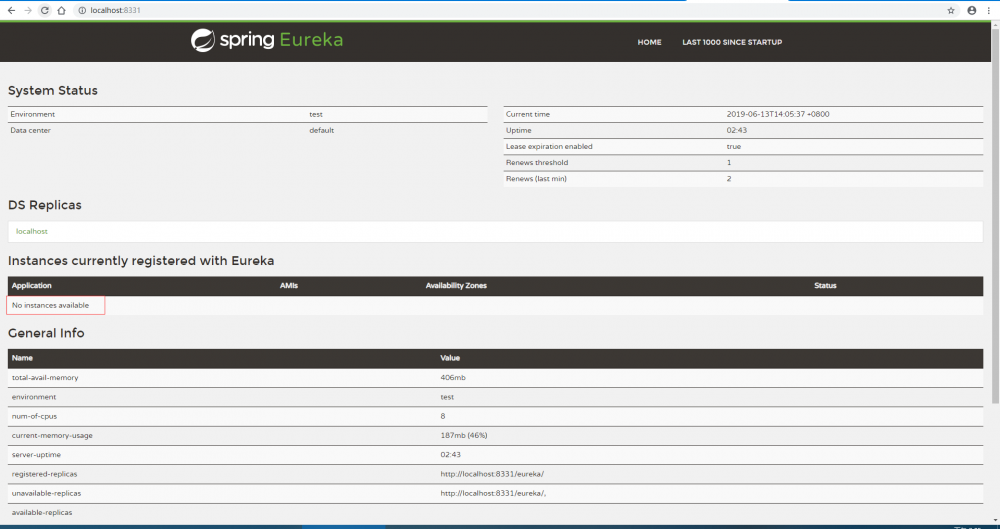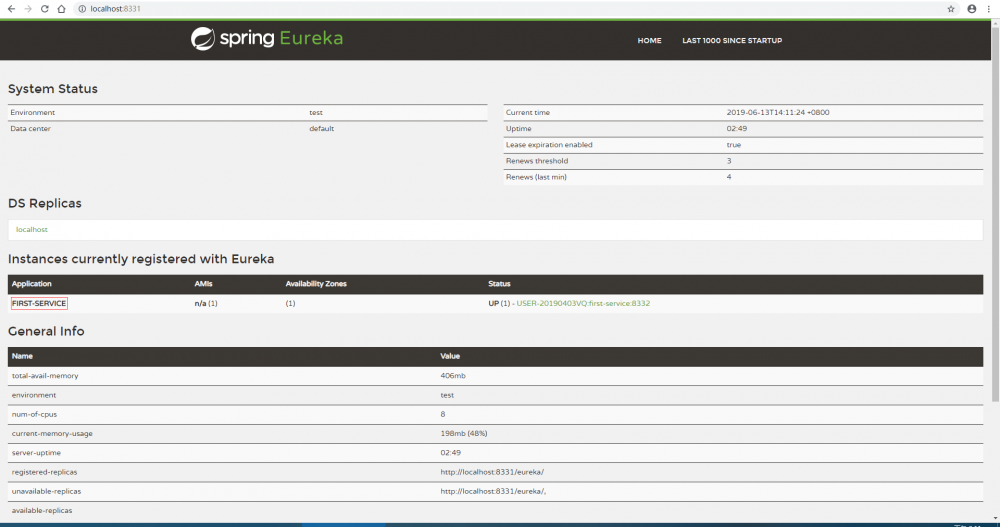【SpringCloud】Eureka入门与原理

为了开发效率高效和业务逻辑清晰,越来越多的项目采用分布式系统。分布式最重要的就是注册中心了。Eureka是SpringCloud原生提供的注册中心,来look一波吧。
超光速入门
服务端
引入依赖:
<dependency>
<groupId>org.springframework.cloud</groupId>
<artifactId>spring-cloud-starter-netflix-eureka-server</artifactId>
<version>Greenwich.SR1</version>
</dependency>
给启动类加上注解@EnableEurekaServer
@EnableEurekaServer
@SpringBootApplication
public class EurekaApplication {
public static void main(String[] args) {
SpringApplication.run(EurekaApplication.class, args);
}
}
配置一下yml文件:
#端口号
server:
port: 8331
#Eureka实例名,集群中根据这里相互识别
eureka:
instance:
hostname: eureka
#客户端
client:
#是否开启注册服务,作为注册中心,就不注册了
register-with-eureka: false
#是否拉取服务列表,这里我只提供服务给别的服务。
fetch-registry: false
#注册中心地址
service-url:
defaultZone: http://localhost:8331/eureka/
启动项目EurekaApplication ,浏览器访问 http://localhost :8331/,Euerka 服务器搭建成功了。

现在还没有东西注册进来。
客户端
引入依赖:
<dependency>
<groupId>org.springframework.cloud</groupId>
<artifactId>spring-cloud-starter-netflix-eureka-server</artifactId>
<version>Greenwich.SR1</version>
</dependency>
这回启动类注解变了,@EnableDiscoveryClient
@EnableDiscoveryClient
@SpringBootApplication
public class ProviderApplication {
public static void main(String[] args) {
SpringApplication.run(ProviderApplication.class, args);
}
}
接下来是配置文件:
#端口号
server:
port: 8332
#Eureka实例名,集群中根据这里相互识别
spring:
application:
name: first-service
eureka:
#客户端
client:
#注册中心地址
service-url:
defaultZone: http://localhost:8331/eureka/
然后启动项目,过一会儿,刷新页面:

注册中心有了刚才那个服务了。这个叫做first-service注册到注册中心,它既可以叫做生产者,也可以被叫做消费者,因为它可以为别的服务提供接口,也可以调用其他服务提供的接口。总之,无论是生产者还是消费者,它都被叫做Client,要用@EnableDiscoveryClient注解。我不小心点进去这个注解里面,发现还有个参数, boolean autoRegister() default true 。这是是否项目已启动,该服务自动注册到注册中心。默认为自动。
除了@EnableDiscoveryClient这个注解以外,还可以使用另外一个注解@EnableEurekaClient。效果相同,如果是Eureka做注册中心的话,建议使用@EnableEurekaClient,如果是其他注册中心的话(例如阿里的nacos),建议使用@EnableDiscoveryClient。
原理
要想运行起来一个个微服务,形成分布式系统,作为注册中心和其中服务,应该实现一下需求:
- 服务们可以顺利注册到注册中心。
- 某服务可以通过注册中心知道注册中心有哪些服务可以使用,并且这一过程需要保证实时性。
- 注册中心需要实时知道服务们是否还存活。
一个服务client注册到注册中心eureka,该client的信息会被存在一个Map中,实现了第一步。同时,client会拉取一份名单,名单里面有其他注册服务的信息,并且为了保证实时性,每30s会再从注册中心那边拉取一份名单信息,实现了第二步。为了确保注册中心实时知道哪些服务还存活着,需要每个client,每隔一段时间(默认30s)向注册中心发送一个心跳,告诉注册中心,我还在,注册中心那份名单拿上还会记录着这个client还可以用,实现了第三步。
先看一眼注册中心,也就是服务端Service,有个启动引导类EurekaBootStrap,其中有个方法:
@Override
public void contextInitialized(ServletContextEvent event) {
try {
initEurekaEnvironment();
initEurekaServerContext();
ServletContext sc = event.getServletContext();
sc.setAttribute(EurekaServerContext.class.getName(), serverContext);
} catch (Throwable e) {
logger.error("Cannot bootstrap eureka server :", e);
throw new RuntimeException("Cannot bootstrap eureka server :", e);
}
}
这方法是初始化Eureka方法的,现在我特别想知道注册中心是用什么数据结构存下客户端client信息的,所以我得去找注册中心为客户端client提供的注册接口,于是乎,点进initEurekaServerContext()这个方法看看,有个PeerAwareInstanceRegistry这个接口,再点进去看看,发现了
void register(InstanceInfo info, boolean isReplication);
看下它的实现类
@Override
public void register(final InstanceInfo info, final boolean isReplication) {
int leaseDuration = Lease.DEFAULT_DURATION_IN_SECS;
if (info.getLeaseInfo() != null && info.getLeaseInfo().getDurationInSecs() > 0) {
leaseDuration = info.getLeaseInfo().getDurationInSecs();
}
super.register(info, leaseDuration, isReplication);
replicateToPeers(Action.Register, info.getAppName(), info.getId(), info, null, isReplication);
}
replicateToPeers() 这个方法用于注册中心是集群的情况,主要是注册完之后,同步该服务给其他eureka节点。
public void register(InstanceInfo registrant, int leaseDuration, boolean isReplication) {
try {
read.lock();
Map<String, Lease<InstanceInfo>> gMap = registry.get(registrant.getAppName());
REGISTER.increment(isReplication);
if (gMap == null) {
final ConcurrentHashMap<String, Lease<InstanceInfo>> gNewMap = new ConcurrentHashMap<String, Lease<InstanceInfo>>();
gMap = registry.putIfAbsent(registrant.getAppName(), gNewMap);
if (gMap == null) {
gMap = gNewMap;
}
}
Lease<InstanceInfo> existingLease = gMap.get(registrant.getId());
... 仿佛有好多代码...
} finally {
read.unlock();
}
}
目测 registry 应该就是储存着所有的服务,点一下看其结构。
private final ConcurrentHashMap<String, Map<String, Lease<InstanceInfo>>> registry
= new ConcurrentHashMap<String, Map<String, Lease<InstanceInfo>>>();
最外层是线程安全的ConcurrentHashMap,key值是registrant.getAppName(),也就是实例中的应用名称 first-service。 里面又是一个ConcurrentHashMap(代码里面是Map接口,但其实肯定是ConcurrentHashMap,你可以看gNewMap 对象怎么new的)。里面这个key是registrant.getId()实例id,value 是Lease<InstanceInfo>,这里面存着服务实例和过期时间什么的。ok,具体注册,今天找到地方,先不看了。
关于client端,需要定时拉取服务名单,定时发送注册中心一个心跳。所以用了两个定时器。
在DiscoveryClient 类中,有个initScheduledTasks() 这个方法,是初始化那两个定时器的,简略代码如下:
private void initScheduledTasks() {
if (clientConfig.shouldFetchRegistry()) {
// registry cache refresh timer
int registryFetchIntervalSeconds = clientConfig.getRegistryFetchIntervalSeconds();
int expBackOffBound = clientConfig.getCacheRefreshExecutorExponentialBackOffBound();
scheduler.schedule(
new TimedSupervisorTask(
"cacheRefresh",
scheduler,
cacheRefreshExecutor,
registryFetchIntervalSeconds,
TimeUnit.SECONDS,
expBackOffBound,
new CacheRefreshThread()
),
registryFetchIntervalSeconds, TimeUnit.SECONDS);
}
if (clientConfig.shouldRegisterWithEureka()) {
int renewalIntervalInSecs = instanceInfo.getLeaseInfo().getRenewalIntervalInSecs();
int expBackOffBound = clientConfig.getHeartbeatExecutorExponentialBackOffBound();
logger.info("Starting heartbeat executor: " + "renew interval is: {}", renewalIntervalInSecs);
// Heartbeat timer
scheduler.schedule(
new TimedSupervisorTask(
"heartbeat",
scheduler,
heartbeatExecutor,
renewalIntervalInSecs,
TimeUnit.SECONDS,
expBackOffBound,
new HeartbeatThread()
),
renewalIntervalInSecs, TimeUnit.SECONDS);
} else {
logger.info("Not registering with Eureka server per configuration");
}
小结
SpringBoot让集成Eureka非常的简单,本篇提供了快速入门的示例。今后还要考虑到注册中心集群的问题。当然,现在还有更好用的注册中心,阿里的nacos,不仅有注册中心的功能,同时还继承了配置中心的功能。了解Eureka工作原理,有助于帮助我们更好的理解分布式系统中的注册中心,为了将来学习了解其他注册中心提供理论基础。
- 本文标签: UI 实例 同步 cache 分布式系统 https 配置 App provider Service springboot 微服务 servlet map 时间 final Action 分布式 ConcurrentHashMap heartbeat 安全 需求 开发 http id HashMap 端口 集群 代码 参数 ECS 服务端 注册中心 服务器 cat Bootstrap Eureka ask 工作原理 配置中心 spring 线程 IDE value src IO Netflix tar 数据 key client executor springcloud
- 版权声明: 本文为互联网转载文章,出处已在文章中说明(部分除外)。如果侵权,请联系本站长删除,谢谢。
- 本文海报: 生成海报一 生成海报二











![[HBLOG]公众号](https://www.liuhaihua.cn/img/qrcode_gzh.jpg)

